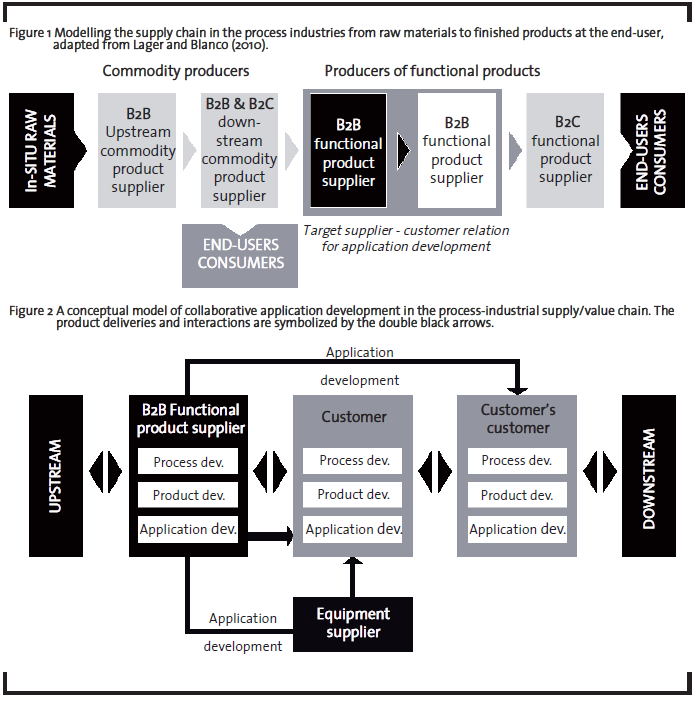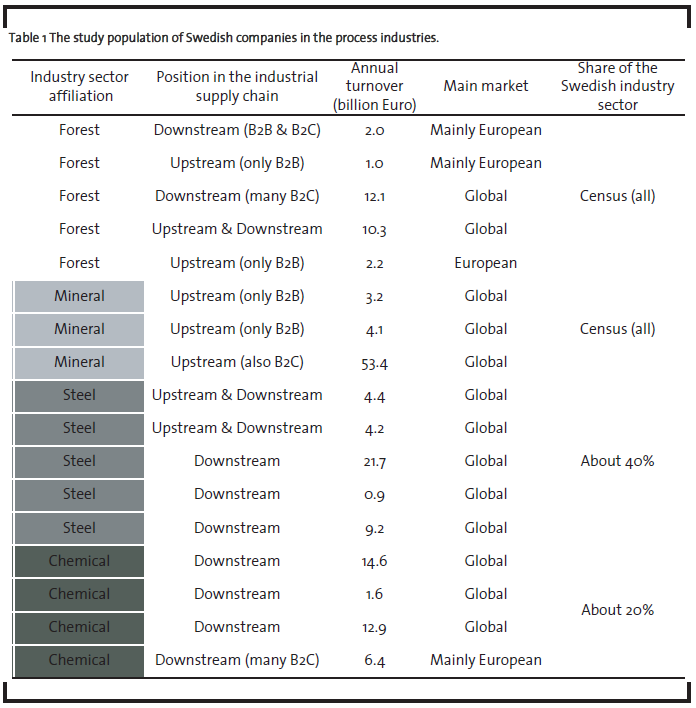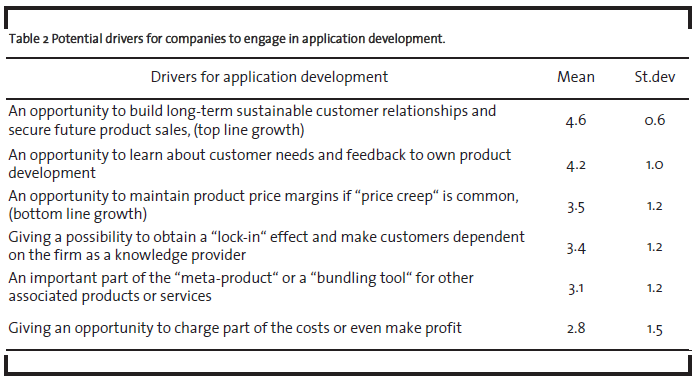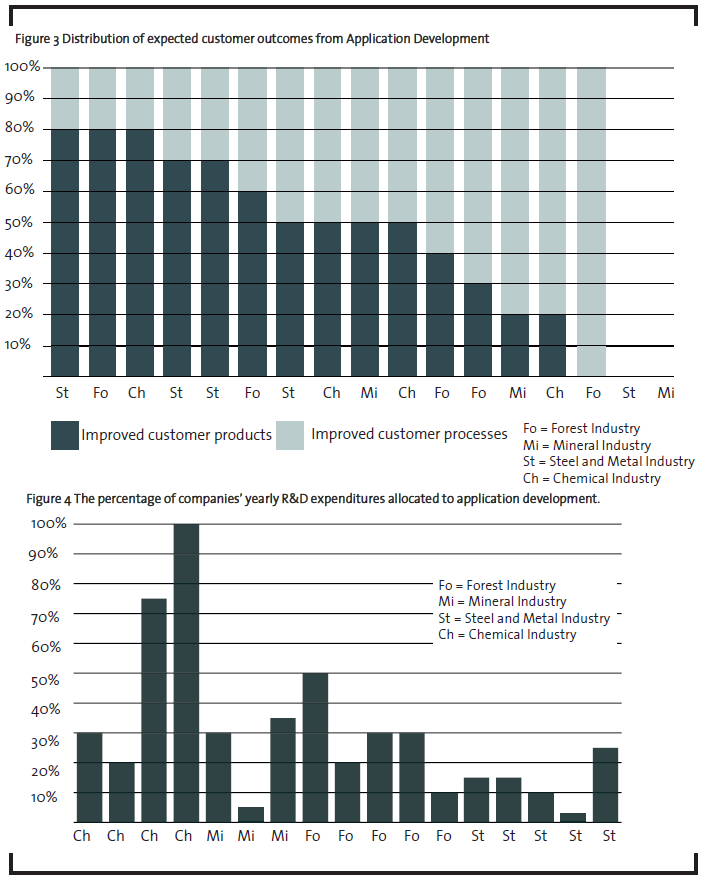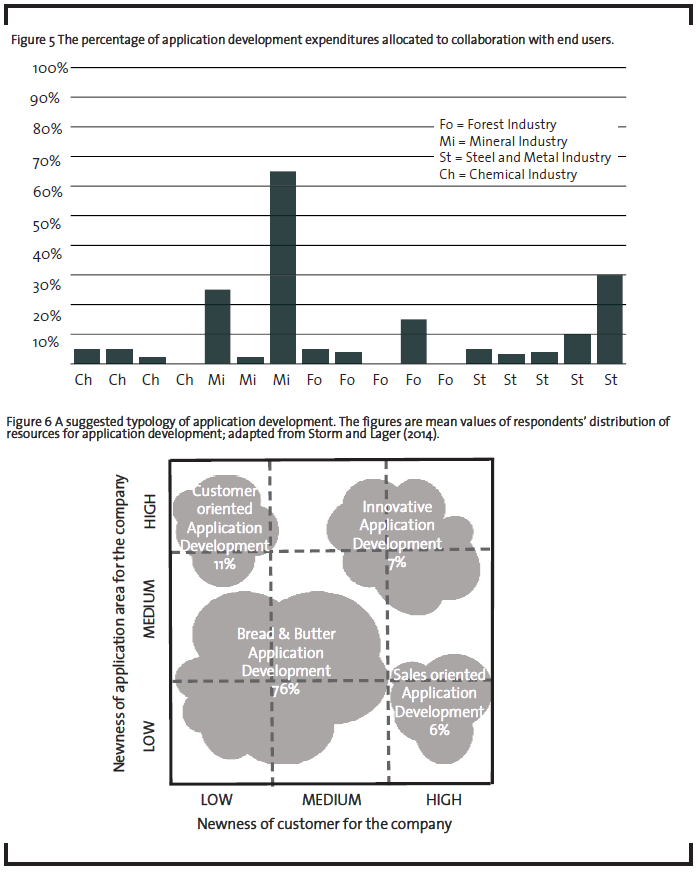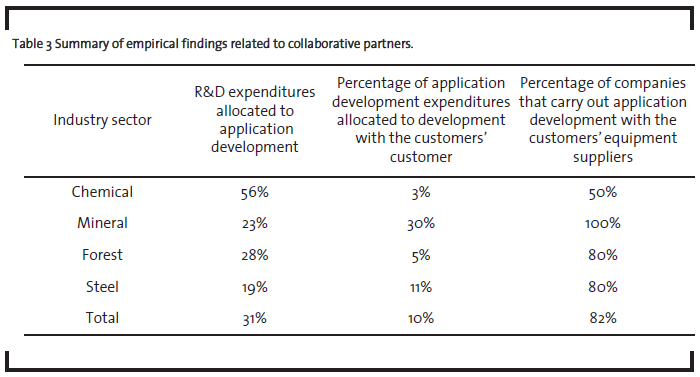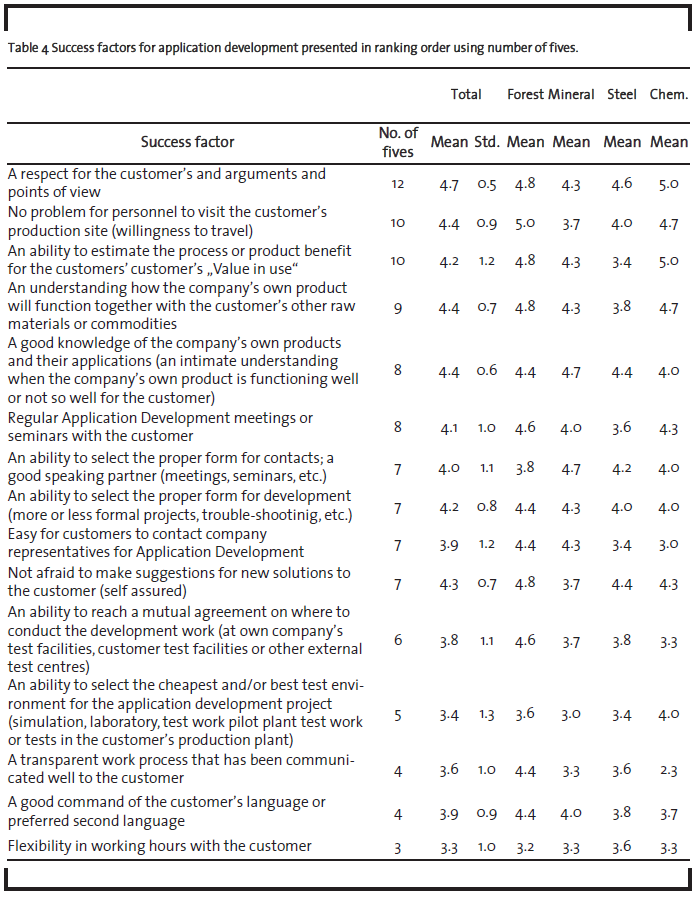Application development in the process industries
The process industries span several industrial sectors, such as minerals and metals, pulp and paper, food and beverages, chemicals and petrochemicals, utilities and pharmaceuticals; thus, they constitute a considerable part of the manufacturing industries. In the family of process industries, a substantial part of company research and development (R&D) lies in the area of helping customers use their supplied products more effectively; this area is generally designated application development in the process industries. Based on the findings from a survey of major process companies in Sweden, the results from three previously publications on different aspects of application development have been merged into a coherent framework. The importance of application development to all companies was judged to be very high, and as a mean value, 30% of all company R&D resources were allocated to application development. Most of the companies in this study carried out application development not only with their customers but also with their customers’ customers and customers’ equipment suppliers. At the extremes, one firm expected 80% of application development to give customers improved products, while the other extreme expected only improved customer process technology. Improving company market shares in the process industries thus depends both on competitive products and on the collaborative development of the customer’s use of those products.
1 Introduction
The process industries span several industrial sectors such as minerals and metals, pulp and paper, food and beverages, chemicals and petrochemicals, utilities and pharmaceuticals, thus constituting a substantial part of all manufacturing industries. A key difference between companies in the process industries and other manufacturing industries is the often long, complex and rigid supply/value chains prevailing in the process industries (Tottie and Lager, 1995). Another important difference is that the products supplied — and often also delivered in the process industries — are mainly semi-finished materials or ingredients of different kinds, not components. One kind of innovation activity related to such products lies in the area of helping its business-to-business (B2B) customers to make more effective use of the supplied products, thereby assisting them in improving their processes and products. This area is generally designated “application development” by industry professionals. In this study, the slightly modified definition of application development presented by Lager (2010) has been used:
Application development is not product development but the significant development of the customer’s use of the supplying company’s products. The development is primarily intended to optimize and to improve the customer’s products and/or production system or to give additional opportunities for other customer cost savings.
Application development constitutes the identification of new application opportunities for a firm’s existing products and sometimes also the potentially required adaptation of those to new application requirements. Therewith, it is positioned – from the perspective of the application-developing company – at the interface between incremental product development, new business development and marketing.
Application development in the process industries has thus far been scarcely researched, and an initial literature review of publications in this area resulted in surprisingly few hits using the key words “application development”. The meagre results from the preliminary literature survey suggested that the concept needed to be grounded in another kind of conceptual framework, starting with previous research in the areas of inter-firm collaboration, open innovation, supply-chain collaboration and product-service integration (Chesbrough and Crowther, 2006, Schiele et al., 2011, Klioutch and Leker, 2011, Shankar et al., 2009).
The authors’ own industrial experiences confirm that companies in the process industries have long since identified this area of development as one of industrial importance. However, there seems to be a scarcity of information or guidelines in academic or industrial publications on this subject area or on how to efficiently manage this kind of development activity. For this reason, a study was initiated in order to close this research gap and investigate different aspects of application development in the process industries with the aim of establishing a first-hand platform of knowledge for further research. Based on the empirical findings from this survey of major process companies in Sweden, the results from three previous publications (Lager and Storm, 2012, Lager and Storm, 2013) on different aspects of application development have been merged into a coherent framework. However interesting the findings from each previously published article did appear, this present review and analysis of the combined results not only emerged as a more holistic and usable industrial framework for company improvements but also created an overall perspective of this topical area to guide further research. The article is organized as follows: In the next section, a synthesis of the previously published articles has been made as a conceptual framework, followed by the research design and study population. The selected empirical findings from the total study are then presented, followed by a discussion of the results and a presentation of the managerial implications. Finally, the conclusions and areas for further research are put forward.
2 A conceptual framework
During tough economic times, companies need new ways to innovate, stimulate growth and drive revenues. By combining a product with service (service in the form of innovation) or vice versa, firms can improve their bottom and top lines (Miller, 1986). Customers increasingly demand integrated solutions that fit their individual needs instead of buying standardized physical goods. Value bundles are, thus, a mixture of physical products and intangible services (Beckeret al., 2010), but in such hybrid offerings firms must comprehend which combination is most appropriate (Garcia and Bray, 1997, Gauthier and Meyronin, 2011, Shankar et al., 2009). A study of the competitiveness of the Swedish process industry (Storm and Bellgran, 2006) noted the importance of the meta-product and customer services. A review of product-service packages found that the greater the degree to which firms customize their products, the more they tend to link products and services into packages; its conclusion was that customization enables firms to learn much more about clients’ long-term needs (Marceau and Martinez, 2002). This study also showed that many firms in all positions in the supply chains were, in fact, producing packages of goods and services and not just products alone. Services with a direct relation to industrial products are, thus, gaining importance in efforts to evolve from producers of goods to problem-solvers for their customers (Lay, 2002), and Rangan & Bowman (1992) also emphasize the service dimension for producers of commodity-like products. In the process industries, application development is one out of many services a product- supplying company can offer its customers, together with its products.
Figure 1 depicts this by the targeted supplier – customer relation representing a bundle of products and services (Lager and Blanco, 2010). There is, however, an important differentiating aspect between “application development” and normal “technical services” provided by the supplier, insofar as the first is an innovation activity related to existing or new products and the second is support based on already available technical knowhow, often addressing problems with malfunctioning existing products. Application development is, thus, a service provided by a supplier as an active involvement in the customer’s process and product innovation activities. Referring to Figure 1, one can also note that application development is a service provided solely to B2B customers, since firms supplying products to consumers do not normally engage in application development activities. In Figure 1, application development is depicted as the relation between a supplier of functional products and its customer.
However, it is also not uncommon that downstream commodity product suppliers actively engage in application development in order to secure a long-term market share. Because of that, application development is to be regarded not only as an industrial marketing tool but also as an important a vehicle for understanding customers’ and customers’ customers’ present and future demands on supplied products. Some companies in the process industries are positioned in the middle of long industrial supply/value chains; for this reason, there are a number of candidates for collaborative application development, which is further illustrated in the conceptual model in Figure 2.
Companies may carry out process development, product development and also application development apart from other activities like applied research and technical support. The first and most obvious target for the supplier is, naturally, the immediate customers in the supply chain, but application development with the customer’s equipment suppliers and end-users may be optional activities. Both functional product suppliers and some downstream and upstream commodity suppliers may benefit from application development. Accordingly, application development, as an institutionalized function in process industry firms, thus focuses on bridging the gap between a product supplier’s knowledge of the product’s performance scope and the customer’s knowledge of its own production process requirements. However, depending on customer needs, application development may not only target the improved use of the supplied product (process innovation) but can also target the improved properties of the customer’s manufactured products (product innovation). The term “collaboration” between firms emphasizes a long-term, effective and continuous relationship between companies, as opposed to limited transactions and/or exchange of information (Frishammar and Hörte, 2005). Regardless of collaboration mode, however, external collaboration as such has both advantages and disadvantages. Advantages include access to resources, economies of scale, risk and cost sharing, enhanced product development, learning and flexibility (Hamel, 1991). Disadvantages include loss of proprietary information, increased complexity in management issues, financial risks, increased resource dependence, and loss of flexibility (Hamel et al., 1989). Since there are both advantages and disadvantages to collaborations, it is important for firms both to identify their own expected outcomes (drivers) for carrying out application development and to clearly identify expected customer outcomes.
3 The study
Because of the scarce research in this topical area, an exploratory survey was considered as a proper research approach.
3.1 Research design and study population
The questionnaire focused on descriptive information gathering, which is a normal approach when researching new topical areas (Yin, 1994). Although the “population of interest” for the study is the global process industry, it was decided early in this research project to include only Swedish companies from the process industries; these companies became the selected “study population”. Since this was an exploratory study, it was decided that the authors’ first-hand knowledge of Swedish companies in the process industries would not only aid in the actual conduct of the survey but would also help to define the study population and facilitate contact with knowledgeable respondents in the companies. The selected companies were located in Sweden, not necessarily having their registered offices in Sweden, but with major production sites and other marketing and sales activities in that country. Only companies estimated to have substantial B2B activities were selected, and most of them had customers on the global market, but some had customers only on the European market. Many were major players within their respective industry sectors and had substantial application development activities. The selected companies are presented in Table 1. The industry sectors included the forest, mineral, steel and chemical industries. The companies were positioned in their industry supply/value chain as either upstream or downstream companies. An upstream manufacturing company is either a producer starting with raw materials or a refiner of raw materials, often into commodities. The downstream producer may then start as a B2B customer for such products, often refining them into more functional products for B2B customers.
3.2 The survey
The questionnaires were distributed after companies and suitable respondents had been located. In most cases, a named person within each company’s R&D organization was contacted by telephone before the mailing, but in a few instances the respondents were simply contacted by e-mail with the questionnaire attached. The response rate was 74% out of a total mailing of 23 questionnaires. For some sectors of the Swedish process industries, the survey can be viewed as a census at the time of the inquiry, as all major companies in the Swedish forest and mineral industries responded. The questionnaire was answered by only one individual respondent in each company, but care was taken to identify a respondent with intimate knowledge in the area of application development. However, in some large multidivisional organizations with different products and customers, the answer from one respondent may represent only one part of the organization. Six respondents did not respond to the questionnaire even after several reminders.
4 A synthesis of empirical findings
4.1 Defining the “application development” concept
In the survey, it was important that all respondents answer the questionnaire starting from a common and well defined application development concept. Thus, it was necessary to propose such a definition in the first part of the questionnaire. The option of presenting alternative definitions or asking the respondents to use their own definition was, therefore, not feasible. In order not to give too much of a bias to the question about the proper definition of the application development concept, the respondents were encouraged afterwards both to comment on the definition used and to suggest alternative definitions.
There was very strong support for the proposed definition (Lager and Storm, 2013). Out of the 17 respondents who answered the question, 14 agreed with the definition without adding any further suggestions or comments. Three respondents did not agree. However, two of those respondents did not reject it outright but suggested improvements. “May improve” was considered a bit too weak a formulation in the definition, and it was felt that the outcome of product improvements should be more strongly emphasized.
4.2 The importance and execution of application development
The importance of innovation to long-term corporate survival and prosperity is never questioned nowadays, and this often includes product innovation, process innovation and, sometimes, also service innovation. The area of application development is however not yet well recognized. The results from asking the respondents how important this activity was in their company showed that application development is an activity of strong importance to many companies in the process industries (Lager and Storm, 2013). On an ordinal scale (1=No importance; 5=Company top priority), the mean value of 4.2 can be considered a high rating; no rating less than three was given, and five companies gave a rating of five. On the other hand, excellence in application development (1=Very poor; 5=World class) received a mean value of 3.7, indicating that there are possibilities for improvement. Five of the respondents stated that their application development capabilities were only average.
4.3 Company drivers and expected customer outcomes
4.3.1 Drivers for company application development
There may be different motives, “drivers”, for companies to engage in application development, and the respondents were asked to rate the importance of a list of six potential drivers. This list is presented in Table 2 together with the means and standard deviations (Lager and Storm, 2013). The topranked driver was “An opportunity to build longterm sustainable customer relationships and secure future product sales (top line growth)”; it received a mean value of 4.6, and its largest number of fives stands out. The question is, unfortunately, “double- barrelled”, as it covers two areas in one question. However, it clearly gives an important summary of overall objectives for application development. The second-highest-ranked driver, “An opportunity to learn about customer needs and feedback to own product development”, received a mean value of 4.2, indicating another important aspect for application development in a company. It points out that one kind of development work in a company, application development in this case, provides important input to another development area, and, thus, that the company’s development could benefit from a more holistic perspective on different kinds of innovation activities.
4.3.2 Customer expected outcomes of application development
The customer may get different outcomes from application development, and the questionnaire proposed the two alternatives as an improved production process or improved finished products. From the results presented in Figure 3, it is evident that both product improvement and process improvement are possible outcomes (Lager and Storm, 2013). Because of the limited number of respondents (two companies did miss to answer the associated questions), one cannot draw too definite conclusions from this material, but there seem to be rather different outcomes for individual companies, even within each sector. This may, of course, be related to different positions in the previously presented value chain in Figure 1 but possibly also to the different divisional affiliations of each respondent. The limited scope of this exploratory survey cannot determine which of these is the case. If one were to try to interpret the distribution at all, there is possibly a tendency for more customer product improvement in the steel industry compared to more customer process improvement for the mineral and forest industries. The large span between 100% improved customer processes to 80% improved customer products is interesting to reflect upon, as such.
4.4 Resource allocation and a suggested typology of application development
4.4.1 Allocation of total company R&D expenditures to application development
Figure 4 presents the percentage of companies’ yearly R&D expenditures allocated to application development by the bars shaded in dark grey.
Resource allocation to application development with the customers varies between 5% and 100%, with a mean value of 31%. The results indicate that the various levels of companies’ application development expenditures are more related to each company’s business environment than to its belonging to a specific industry sector. Since an average of one third of total R&D spending is allocated to application development, it can be concluded that application development is a significant and important area of R&D for most of the companies in this study.
The percentage of application development expenditures allocated to collaboration with endusers is illustrated in Figure 5, showing the somewhat surprising fact that nearly all companies (82%) in this study actually collaborate in application development with the customers’ customers. Resources for application development with endusers as part of overall application development expenditures vary from 0% to 65%, with a mean value of 10%. Also in this case, there seem to be little co-variation on an industry-sector level.
Accordingly, the main body of application development for most companies is carried out immediately downstream in the supply/value chain, since only minor resources are used for collaborative work with the customers’ customers (with the exception of one chemical and two forest companies who do not show any application development in collaboration with the customers’ customers).
4.4.2 Distribution of company application development resources – a typology
The respondents were asked to position and distribute their company application development expenditures using a matrix presented in the questionnaire. In the results analysis, the structural dimensions and scales from the original matrix were retained, but the number of areas in the matrix was reduced to four, a common practice in sociological data analysis (Barton, 1955). Those four areas were also labeled by the authors in the research results analysis, thereby creating a typology of application development areas and of customers’ different levels of newness. Figure 6 presents the results, where the figures are mean values. Selected associated comments from the respondents regarding the different areas of the matrix (presented in the following in italics), guided and highlight the labeling of the different matrix areas.
As presented in Figure 6, the main body of application development is carried out together with well-known customers and as application development of little newness to the company. The area “bread and butter application development” can thus be looked upon as a “comfort zone” for application development, since it seems to be an easily accessible area for application development. This area is obviously the “schwerpunkt” and focus for application development to which most company application development resources are distributed. One comment from the respondents:
This is where most application development is done with old customers improving the use of the supplying company’s products. Application development in this area is focusing on cost effectiveness for both suppliers and customers. It is very important to have a good and open relationship with customers, in which you can discuss their process problems and try to find solutions to them.
The area “sales-oriented application development” can be looked upon as a “grey area” when it could be partly agglomerated with other businessand marketing activities. However, the different competence profiles of people involved (Lager and Storm, 2013) merit the inclusion of these activities as true company application development. One comment from the respondents:
This is a natural area for companies expanding into new markets and using application development experiences to develop new customers.
The area “customer-focused application development” is analogous to the sales-oriented application development area. The cost-efficiency perspective and desire to retain existing customers may explain the higher figure in this area compared with that of sales-oriented application development. One comment from the respondents:
This is a truly customer-focus area, when you follow your (hopefully important) customers in their development activities. Application development in this area has a high chance of success because you can move into unchartered waters with a trusting and trustworthy partner. A key application development area to be in, when moving into new applications.
In the area of “innovative application development”, it is possible that the overlap between product development activities is more common, since the newness of the application development area in combination with new customers may result in a need for more product adaptions. One comment from the respondents:
This is innovative application development in need of joint company internal technical and marketing efforts in the innovation process in order to implement new applications with new customers. A high-risk area but also with a high reward potential.
After using the matrix, the respondents were asked about its usefulness for the characterization of different kinds of application development. The mean value was 3.4, making it evident that the matrix did not appeal to all respondents; however, some respondents believed it was very useful, since 55% of the respondents rated the matrix with 4s or 5s.
4.5 Selection of collaborative partners
Table 3 presents a summary of the empirical results. Around one third of companies’ total R&D resources are allocated to application development as defined in this study and the figure for the Chemical industry stand out. Referring to the second column, the bulk of those resources are spent immediately downstream since the figures in this column show that only average 10% of the company resources for application development are spent on application development with the customers’ customers. Referring to the previously presented Figure 6, those resources are mainly allocated to well-known customers and application areas (the “bread and butter” area of application development). The companies in the chemical industries and, to some extent, the forest industries, stand out in terms of the amount of total resources allocated to application development and the amount of resources spent immediately down-stream in the supply chain. In column 3 it is shown that the majority of all companies in this study carry out application development with the customers’ equipment suppliers. This indicates that collaboration between companies in the process industries and equipment suppliers is an important activity and an area of interest for further research (Lager and Frishammar, 2012).
4.6 Success factors and the application developer of excellence
Success factors for application development have been structured on three firm levels: strategic success factors, tactical success factors and operational success factors (Lager and Storm, 2012). Company strategic success factors are those for application development related to decisions and behaviour on the firm group level or R&D top management level. Tactical success factors in this study are those related to the capabilities of the application engineer and the personal traits of the application developer of excellence. Finally, operational success factors are those more related to the behaviour of application engineers in the context of, and collaboration with, customers.
4.6.1 Strategic success factors
The respondents were asked to suggest potential areas for further improvement of their firms’ application development on a strategic level. Several of these were left blank, possibly because they shared the same view as some other respondents who said outright that this kind of information was confidential. However, some of the respondents came up with suggestions for strategic success factors, presented as follows:
- Application development ought to be included in the company’s business development activities and strategic planning.
- Necessary resources should be dedicated to this area, and they should be better co-ordinated in large companies.
- Potential areas for application development should be analysed better in order to identify opportunities that may have been overlooked, like improved logistics and material handling. Get away from too many inside-out perspectives.
- Start a separate application development team focusing only on the development of new applications (becoming a trend-setter).
- There is a need for a better evaluation of the firm’s application development and project screening methodology, also from an economic point of view.
4.6.2 Tactical success factors
The respondents were asked to characterize the present and future “application engineer of excellence” (Lager and Storm, 2012). This part of the questionnaire generated many traits of such a person; the following statement gives a flavor of the respondents’ answers:
The application development engineer should first of all have an excellent knowledge about the customer’s production processes and preferably own experience. It is important that he/she understands that each customer is “unique” and thus that the first move is to comprehend this uniqueness. The person should preferably have a university education as a platform. Product Manager, Company F
All answers were treated using an affinity technique, and the total answers were thus reduced into the four areas (italics) introduced as follows. An engineer with a solid background, preferably with a university education as a platform and recruited, if possible, from the customer industrial sector rather than from one’s own ranks. As such, the person should have an excellent knowledge of the customers’ production processes but additionally have a good commercial knowledge and business sense. In order to be able to carry out efficient application development, he/she must possess strong project management skills. That includes a strategic skill in project selection and a capability to “drive” his/her own organization more than the customer’s organization and a capacity to complete started application development projects. Finally, the person should possess an eagerness to achieve results and an ability to work closely with marketing people. The application developer must be socially competent and generally pleasant behaviour is desirable, such as a quality of listening to the customer in order to understand his needs but also an ability to communicate well internally and with the customer.
The application developer must have an attitude that transfers a “win-win” application development goal to the customer and, last but not least, the application developer of excellence must have aninnovative personality. The following traits were mentioned as belonging to such a personality:
- A capacity to generate good “key ideas”
- An open mind ready for new ideas
- Trustful and reliable in customer relations
- An easy-going and optimistic nature
- Having a general philosophy that each customer is unique and that the first move is to understand this uniqueness
- An instinctive behaviour of trying to imagine the impact of improved use of products supplied to the customer
Collaborating in either product or process innovation at the customers’ premises is presumably a rather difficult undertaking that requires long experience by an application engineer. The respondents presented a list of personal qualities and skills that support this notion. It is, thus, not only necessary that the application development engineer have a solid engineering background and expert knowledge of the customer’s product and process technology but he/she must also have strong project management skills, be socially competent and, probably foremost of all, be innovative! The conclusion is, thus, that selecting or recruiting such a person into an organization is an activity of strong importance and, thus, also very likely to be an important tactical success factor for application development.
4.6.3 Operational success factors
Table 4 presents operational success factors in ranking order of the number of fives from the respondents. The top-ranked success factor received 12 fives out of 17, while the lowest-ranked received only 3. Out of the 15 potential success factors, the three top-ranked ones were:
- Respect for the customer and the customer’s arguments and points of view;
- No problem for personnel to visit the customer’s production site (willingness to travel);
- Ability to estimate the process and product benefits for the customer (customer’s “value in use”).
Being a good listener is a virtue that is often preached by salespeople as a way to discover a customer’s needs. The second success factor stresses the importance of visiting the customer, a fact that may sound trivial but, nevertheless, is the most important prerequisite for every successful application development project. The third success factor points out the importance of trying to estimate customer benefits received from application development.
5 Discussions and managerial implications
If a company recognizes the topical area of application development as relevant and important, it is recommended that it should not only be discussed on an R&D management level but also be elevated to the group management level, taking a fresh look at the company’s present application development activities and also reviewing project screening and resource allocation. It is also suggested that the company could use the presented results from this study in their own improvement efforts, not only to develop complementary company- specific drivers for application development but also to benchmark the importance for the company of the potential drivers presented in this article. On a company strategic level, it is important to distinguish between supplier-customer collaborations on a project-by-project basis and collaborations on a strategic level, when application development is viewed from a long-term, holistic perspective. On a company tactical level, since application development often requires a substantial share of the supplying company’s technical resources, it is also important to carefully analyse with whom to collaborate. The presented matrix has, then, the potential to be useful in discussions of what application development is all about and with whom to collaborate, thus helping to “projectify” such development activities. It might then also be appropriate to consider whether the balance between different types of application development activities is good or, conversely, whether strategic changes are needed in the future.
Since collaborating in either product or process innovation at the customers’ premises is presumably a rather difficult undertaking requiring long experience, the company ought not only to be constantly on the lookout for persons with such skills but should also plan skill development of existing staff that includes providing proper supplementary training, if needed. The list of potential personal traits for an application development engineer could be an embryo and a template for exploring this area further; it could also be developed into some sort of benchmarking instrument for management use in discussions with the staff. The rated list of operational success factors, together with the list of new potential success factors for application development, can be used as a guideline and trigger for internal discussions of good behaviour on a more company operational level. The application engineer, with an intimate knowledge of the company’s products and their uses in the customers’ production processes, is in an excellent position to set up development activities in collaboration with the customer’s production experts in order to improve the customer’s overall production economy and to add value to the customer’s production system. Improved use of the supplying company’s products on the customer’s premises may, however, also give interesting opportunities to improve and add value to the customer’s products. The latter is an area probably not so well explored in some companies, since it requires good relations not only with the customer’s process development organization but also with its product development teams. A company that today focuses on either product or process innovation as customer outcomes could possibly benefit from reflecting on whether the other alternative is also worth exploring. Depending on whether the target is product or process improvements for the customer, this may possibly require different application development strategies and, by extension, different skills in application development.
6 Conclusions and further research
Improving company market shares in B2B customer relations not only depends on competitive products but also on the collaborative development of the customer’s use of those products. The importance of a company’s product and process development is not usually questioned at the top management level, and the results of this study suggest that application development should also be considered a complementary and important aspect of company R&D in the process industries.
This has been illustrated in Figure 7, and the study area has because of that been given a black shading. Another area of importance for companies in the process industries is raw-material development. This area is not normally discussed and has thus been given no shading at all, symbolizing that this is a “white space” on the R&D Management research map for the process industries. It is important not only to balance company total resources and capabilities for all four different development activities well but also to improve company work-processes that facilitate their integration and synergy. The arrows to the right in the figure are thus symbolizing the material flow, while the arrows to the left are symbolizing the necessary flow of information and customer demands that should be progressed backwards into the company organization.
However, the outcome of application development in collaboration with company customers may vary significantly in the “customer process/customer product” development space. Whether improving the customer’s product performance (top-line growth for the customer) or reducing the customer’s process costs (bottom-line growth for the customer) or both, the area of application development should be considered in the future as a development area of importance equal to that of product development and process development in the process industries.
Moreover, product development projects in the process industries may, in a three dimensional development space, also contain a share of process development and application development. Because of that, it is important not only to balance company total resources and capabilities for all three different development activities well but also to improve company work-processes that facilitate their integration and synergy. Application development, as an institutionalized function in firms in the process industries, focuses on bridging the gap between a product supplier’s knowledge of the product’s performance scope and the customer’s knowledge of its production process requirements and demands on delivered products. Therefore, identifying the required capabilities for mediating between these knowledge pools is highly relevant and seems to be a missing piece in the collaboration and open innovation management literature. One limitation of this study is that the study population includes only process companies that are based in Sweden. However, because most of them have production plants and customers on a global market, it is argued that the research findings may be relevant and of value to the larger worldwide population of interest.
Not only does this look like an interesting new avenue for further research, but the present research results can already give initial suggestions for company improvements. It is evident from this study that both product and process improvements are possible customer outcomes from application development. Since most studies on supplier-customer relations focus only on product innovation improvements for the customer, the findings are new evidence that ought to be considered in further research. The different possible targets for the application developer may thus require quite different approaches and personal capabilities, which may be of interest for further exploration. Because application development is mainly carried out at the customer’s premises, sometimes in a close collaboration with equipment suppliers and customers’ customers (end-users), the development of formal work processes for application development is recommended for further research. Prior research has paid less attention to innovation in the process industries than to innovation in other manufacturing industries. Previous research on managing innovation in the process industries has focused mainly on product development and to a lesser extent on the area of developing new process technology. Application development is now another area that should be added in innovation management research.
7 Acknowledgements
We sincerely thank all respondents for spending their valuable time answering the long questionnaire. An early version of this paper was presented at the R&D Management conference 2014 in Stuttgart. Many thanks to the two anonymous reviewers of this paper. You provided both helpful comments and important suggestions.
References
Barton, A. H. (1955): The concept of property-space in social research, In: LAZARSFELD, P. F. & ROSENBERG (eds.) The language of social research. The Free Press.
Becker, J., Beverungen, D. F. and Knacksted R. (2010): The challenge of cenceptual modeling for product- service systems: status-quo and perspectives for reference models and modeling languages, Inf Syst E-Bus Manage, 8, 33-66.
Chesbrough, H. and Crowther, A. K. (2006): Beyond high tech: early adopters of open innovation in other industries, R&D Management, 36, 229- 236.
Frishammar, J. and Hörte, S. Å. (2005): Managing External Information in Manufacturing Firms: The Impact on Innovation Performance, Journal of Product Innovation Management, 22, 251- 266.
Garcia, M. L. and Bray, O. H. (1997): Fundamentals of Technology Roadmapping, Albuquerque NM: Sandia National Laboratories.
Gauthier, C. and Meyronin, B. (2011): Designing a service for sustainability, The R&D Management Conference, Norrköping.
Hamel, G. (1991): Competition for Competence and Inter-Partner Learning within International Strategic Alliances, Strategic Management Journal, 12, 83-103.
Hamel, G., Doz, Y. and Prahalad, C. (1989): Collaborate with your competitors and win, Harvard Business Review, 89, 133-139.
Klioutch, I. and Leker, J. (2011): Supplier involvement in customer new product development: new insights from the supplier’s perspective, International Journal of Innovation Management, 15, 231-248.
Lager, T. (2010): Managing Process Innovation – From idea generation to implementation, London, Imperial College Press.
Lager, T. and Blanco, S. (2010): The Commodity Battle: a product-market perspective on innovation resource allocation in the Process Industries, International Journal of Technology Intelligence and Planning, 6, 128-150.
Lager, T. and Frishammar, J. (2012): Collaborative development of new process technology/equipment in the process industries: in search of enhanced innovation performance, Journal of Business Chemistry, 9, 3-19.
Lager, T. and Strom, P. (2012): Application development in supplier-customer collaborations: success factors for firms in the process industries, International Journal of Technology Marketing, 7 (2), 151-176.
Lager, T. and Storm, P. (2013): Application development in process firms: adding value to customer products and production systems, R&D Management, 43, 288-302.
Lay, G. (2002): Serviceprovider Industry: Industrial Migration From Manufacturing To Selling Products And Services – Trends and Impacts, Karlsruhe: Frauenhofer Institute for Systems and Innovation Research.
Marceau, J. and Martinez, C. (2002): “Selling solutions”: Product-Service Packages as links between new and old economies, DRUID Summer conference on Industrial Dynamics of New and old Economy. Copenhagen.
Miller, D. (1986): Configurations of Strategy and Structure: Towards a Synthesis, Strategic Management Journal, 7, 233-249.
Rangan, K. V. and Bowman, G. T. (1992): Beating the Commodity Magnet, Industrial Marketing Management, 21, 215-224.
Schiele, H., Veldman, J. and Huttinger, L. (2011): Supplier Innovativeness and Supplier pricing: The role of Preferred Customer Status, International Journal of Innovation Management, 15, 1-27.
Shankar, V., Berry, L. L. and Dotzel, T. (2009): A Practical Guide to Combining Products Services, Harvard Business Review, November, 95-99.
Storm, P. and Bellgran, M. (2006): Increased Competitiveness for Swedish Process Industry, Royal Swedish Academy of Engineering sciences (IVA).
Tottie, M. and Lager, T. (1995): QFD-Linking the Customer to the Product Development Process as a Part of the TQM Concept, R&D Management, 25 (July), 257-267.
Yin, R. K. (1994): Case Study Research; Design and Methods, Thousand Oaks, Sage Publications.
